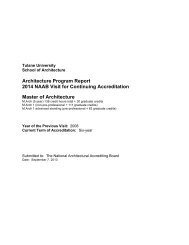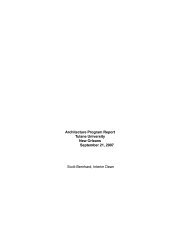NAAB Conditions for Accreditation, 2009 - Tulane School of ...
NAAB Conditions for Accreditation, 2009 - Tulane School of ...
NAAB Conditions for Accreditation, 2009 - Tulane School of ...
You also want an ePaper? Increase the reach of your titles
YUMPU automatically turns print PDFs into web optimized ePapers that Google loves.
<strong>2009</strong> <strong>Conditions</strong> <strong>for</strong> <strong>Accreditation</strong><br />
National Architectural Accrediting Board, Inc.<br />
PART TWO (II): SECTION 1 – STUDENT PERFORMANCE -- EDUCATIONAL REALMS & STUDENT<br />
PERFORMANCE CRITERIA<br />
The accredited degree program must demonstrate that each graduate possesses the<br />
knowledge and skills defined by the criteria set out below. The knowledge and skills are the<br />
minimum <strong>for</strong> meeting the demands <strong>of</strong> an internship leading to registration <strong>for</strong> practice.<br />
The school must provide evidence that its graduates have satisfied each criterion through<br />
required coursework. If credits are granted <strong>for</strong> courses taken at other institutions or online,<br />
evidence must be provided that the courses are comparable to those <strong>of</strong>fered in the<br />
accredited degree program.<br />
The criteria encompass two levels <strong>of</strong> accomplishment 10 :<br />
<br />
<br />
Understanding—The capacity to classify, compare, summarize, explain and/or<br />
interpret in<strong>for</strong>mation.<br />
Ability—Pr<strong>of</strong>iciency in using specific in<strong>for</strong>mation to accomplish a task, correctly<br />
selecting the appropriate in<strong>for</strong>mation, and accurately applying it to the solution <strong>of</strong> a<br />
specific problem, while also distinguishing the effects <strong>of</strong> its implementation.<br />
The <strong>NAAB</strong> establishes per<strong>for</strong>mance criteria to help accredited degree programs prepare<br />
students <strong>for</strong> the pr<strong>of</strong>ession while encouraging educational practices suited to the individual<br />
degree program. In addition to assessing whether student per<strong>for</strong>mance meets the<br />
pr<strong>of</strong>essional criteria, the visiting team will assess per<strong>for</strong>mance in relation to the school’s<br />
stated curricular goals and content. While the <strong>NAAB</strong> stipulates the student per<strong>for</strong>mance<br />
criteria that must be met, it specifies neither the educational <strong>for</strong>mat nor the <strong>for</strong>m <strong>of</strong> student<br />
work that may serve as evidence <strong>of</strong> having met these criteria. Programs are encouraged<br />
to develop unique learning and teaching strategies, methods, and materials to satisfy these<br />
criteria. The <strong>NAAB</strong> encourages innovative methods <strong>for</strong> satisfying the criteria, provided the<br />
school has a <strong>for</strong>mal evaluation process <strong>for</strong> assessing student achievement <strong>of</strong> these criteria<br />
and documenting the results.<br />
For the purpose <strong>of</strong> accreditation, graduating students must demonstrate understanding or<br />
ability as defined below in the Student Per<strong>for</strong>mance Criteria (SPC):<br />
II.1.1 Student Per<strong>for</strong>mance Criteria: The SPC are organized into realms to more easily<br />
understand the relationships between individual criteria.<br />
Realm A: Critical Thinking and Representation:<br />
Architects must have the ability to build abstract relationships and understand the impact <strong>of</strong><br />
ideas based on research and analysis <strong>of</strong> multiple theoretical, social, political, economic,<br />
cultural and environmental contexts. This ability includes facility with the wider range <strong>of</strong><br />
media used to think about architecture including writing, investigative skills, speaking,<br />
drawing and model making. Students’ learning aspirations include:<br />
Being broadly educated.<br />
Valuing lifelong inquisitiveness.<br />
10 See also Taxonomy <strong>for</strong> Learning, Teaching and Assessing: A Revision <strong>of</strong> Bloom’s Taxonomy <strong>of</strong><br />
Educational Objectives. L.W. Anderson & D.R. Krathwold, Eds. (New York; Longman 2001).<br />
21














